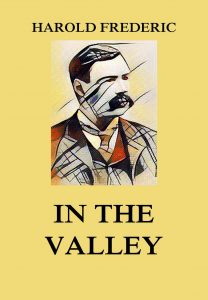In the Valley – Harold Frederic
Harold Frederic has added a most picturesque and interesting region to those celebrated in American fiction. The Mohawk valley of central New York is rich in tradition, in the memory of stirring events, brave deeds, and heroic men, and, above all, in the patriotism of its people. It is endeared to the author of this story by the associations of his youth, and he has already made it the setting for two novels of modern life. In “In the Valley” Mr. Frederic has gone back to the romantic period of the French and Indian, and Revolutionary wars. The daring men and remarkable adventures are the background for a love romance, which is the chief interest of the story. In bloody and cruel times we see an idyllic and pure love grow and flourish in a strong yet tender man. One great charm of the tale is the vigorous but beautiful style in which the old man recalls his story. It is a consistent and faithful reproduction of the stately English of Colonial gentlemen. Altogether this novel is a significant addition to our patriotic literature, which lends dignity to the traditions of our early history.
In the Valley.
ISBN: 9783849681937
Available at amazon.com and other venues.
Biography of Harold Frederic (from Wikipedia):
Frederic was born in Utica, New York, to Presbyterian parents. After his father was killed in a railroad accident when Frederic was 18 months old, the boy was raised primarily by his mother. He finished school at age fifteen, and soon began work as a photographer. For four years he was a photographic touch-up artist in his hometown and in Boston. In 1875, he began work as a proofreader for the newspaper The Utica Herald and then The Utica Daily Observer. Frederic later became a reporter. Frederic married Grace Green Williams in 1877, and they had five children together. By 1882 he was editor of the newspaper The Albany Evening Journal in the state capital.
In 1884 Frederic went to live in England as London correspondent of the New York Times, and worked at this position for the rest of his life. He brought his family to London by 1889. Afterward he met Kate Lyon, who became his mistress. Frederic and Lyon established a second household, living openly together; and they had three illegitimate children.
Frederic wrote several early stories, but it was not until he published Illumination (1896), better known by its American title, The Damnation of Theron Ware; followed by Gloria Mundi (1898), that his talent as a novelist was fully realized. Critic Jonathan Yardley called Damnation “a minor classic of realism”.
Kate Lyon was a Christian Scientist.Frederic suffered a stroke in 1898. After his death, she was tried on charges of manslaughter brought by his wife Grace Frederic, and acquitted at trial.
(The text of the last section was taken from a Wikipedia entry and is available under the Creative Commons Attribution-ShareAlike License.)
Publisher’s Note: This book is printed and distributed by Createspace a DBA of On-Demand Publishing LLC and is typically not available anywhere else than in stores owned and operated by Amazon or Createspace.

